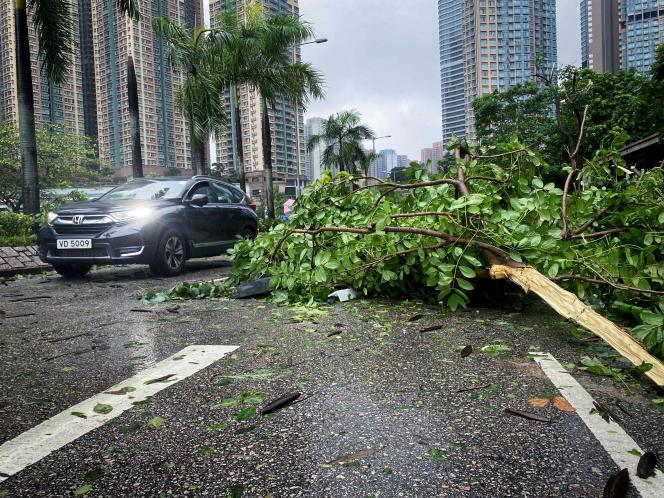THE Chinese National Meteorological Center (CMN) announced that Saola made landfall on Saturday, September 2 in the morning at around 3:30 a.m. local time (10:30 p.m. Friday, Paris time) south of the city of Zhuhai, in the province of Guangdong. First classified as a supertyphoon, Saola was downgraded to a severe typhoon. “Saola could become the strongest typhoon since 1949 to hit the Pearl River Delta”which includes several major cities such as Hong Kong, Guangzhou, Shenzhen and Macau, had predicted the Meteorological Center on the Weibo social network.
Tens of millions of people in Hong Kong, Shenzhen and other major cities in this area have sealed themselves off at home. More than 880,000 people have been evacuated in two Chinese provinces and hundreds of flights have been cancelled. In Hong Kong, in deserted and rain-battered streets, trees have already been uprooted. The start of the school year has been postponed in anticipation of the arrival of Saola.
The Hong Kong authorities had raised the alert level from T8 to T9 at the end of the day on Friday, then to T10, the maximum, issued only sixteen times since the Second World War. At 3:40 a.m., after more than seven hours under T10, Hong Kong moved to the T8 level. But with gusts of up to 139 km / h, the authorities asked residents to remain vigilant.
Public transport suspended in Shenzhen
Hours before the typhoon landed, only a few people looking for last-minute shopping were out, as Mme Lee, accompanied by her granddaughter. According to her, the government made the right choice by delaying the start of the school year. “It is better to wait until this is over before sending the children to school”she said.
Storefronts and windows in businesses and homes have been protected with duct tape, while office buildings near Victoria Harbor have barricaded entrances to try to keep water out. The Hong Kong Airport Authority announced the cancellation of more than 300 flights on Friday. The Stock Exchange canceled the “morning trading sessions for all markets”.
In mainland China, Guangdong province, where 780,000 people were evacuated from high-risk areas, suspended train traffic until Saturday evening, and 100,000 people were also evacuated in Fujian province.
Shenzhen, one of the country’s main economic centers, has ordered the closure of offices, shops and markets and opened shelters for the population. All public transport in this city of 17.7 million people ceased service in the evening, while trains to and from Guangzhou are suspended until 6 p.m. local time on Saturday.
“My eldest son was supposed to go to Chengdu University today. [centre] but his flight was cancelled”, said Wu Wenlai, 43, a restaurant owner in the suburbs of Shenzhen. But he is not worried despite the warning from the authorities. “We are used to it. We usually have several typhoons a year”.
Risk of “severe flooding”
Dozens of delivery drivers braved strong winds and rain to reach residents who had taken refuge in their homes. “I will work until I feel it is too dangeroussaid one of them to Agence France-Presse, Chai Jijie, 22. “People don’t want to go out but want to have provisions. There are a lot of delivery requests. »
Newsletter
” Human warmth “
How to face the climate challenge? Each week, our best articles on the subject
Register
“There could be severe flooding in the eastern coastal areas, underlines the meteorological observatory, which considers possible water levels similar to those caused by Typhoon Mangkhut in 2018. More than 300 people were injured in Hong Kong. In mainland China, it had affected more than three million people in the southern provinces, killing six.
In a low-lying fishing village in flood-prone Lei Yue Mun district, water has already risen, seeping into shops, where sandbags barricade closed doors. “We raised [les appareils électroménagers] so that the water does not damage them »a restaurateur named Lee told a local television station, hoping to preserve his business.
Southern China is frequently hit by typhoons that form in the warm oceans east of the Philippines in summer and autumn and then move west. Although they can temporarily disrupt activity in cities like Hong Kong and Macau, typhoons cause far fewer casualties and damage, thanks to stricter building standards and better flood management systems.
Climate change has increased the intensity of tropical storms, with more rainfall and stronger gusts causing flash flooding and coastal damage, experts say.
